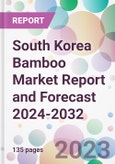Market Outlook
According to the report the South Korea bamboo market is projected to grow at a CAGR of 4.7% between 2024 and 2032 to reach a value of about USD 187.72 million by 2032. Aided by the escalating demand for sustainable materials and bamboo's versatility in a plethora of applications, the market is expected to grow significantly by 2032.Bamboo, often deemed as the 'green steel' of the 21st century, is a rapidly renewable resource that possesses exceptional strength and flexibility. It's not only an ecological alternative to timber, plastic, and even steel in some cases, but its application spans across a myriad of industries, from construction and furniture to paper and textiles in South Korea. Furthermore, its cultural significance, coupled with modern-day utility, amplifies its demand in both traditional and contemporary sectors.
Several dynamics influence the South Korea bamboo market outlook. At the forefront is the nation's commitment to sustainable and green growth. As concerns over deforestation and environmental degradation amplify globally, bamboo emerges as an eco-friendly substitute due to its fast growth rate and carbon sequestration capabilities.
South Korea's rich history and tradition with bamboo craft also play a pivotal role in the surge in the South Korea bamboo market demand. The art of 'jukbuin' or bamboo crafts, which encompasses everything from daily use objects to artistic sculptures, remains a significant part of the country's cultural heritage. This tradition has seamlessly merged with contemporary design, leading to innovative bamboo products that cater to both functional and aesthetic needs.
Furthermore, the health and wellness wave sweeping South Korea has accentuated the demand for bamboo-based products. Bamboo extracts, renowned for their antioxidant and anti-inflammatory properties, have seen a surge in the cosmetic and skincare industries. Also, the bamboo salt, produced through a traditional Korean method of roasting bamboo stems filled with salt, is increasingly sought after for its purported health benefits.
As per the South Korea bamboo market analysis, the construction sector, too, has embraced bamboo owing to its robust tensile strength and flexibility. With urban areas in South Korea increasingly exploring sustainable building solutions, bamboo-based architectures and interiors are gaining momentum. Not to mention, the country's focus on promoting tourism tied to eco-friendly and traditional themes has seen bamboo being utilised in resort and park constructions.
Market Segmentation
The market can be divided based on application.Market Breakup by Application
- Wood and Furniture
- Flooring and Ceiling
- Outdoor Decking
- Furniture
- Others
- Construction
- Pulp and Paper
- Textile
- Shoots
- Others
Table of Contents
Methodology

LOADING...








